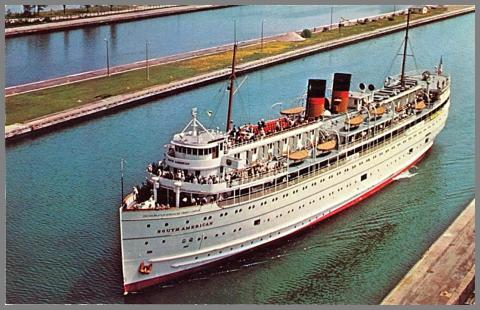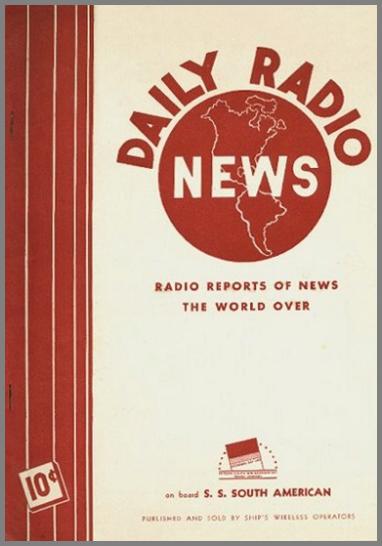
The Chicago, Duluth & Georgian Bay Transit
Co.
aka - Georgian Bay Line
SS North American - SS South American - SS Alabama

The
SS South American was one of the last Great lakes ships to use CW
Photo courtesy of Tom Drake
Wikipedia has good general information on the history of the Georgian Bay Line and its three ships: The SS North American, the SS South American and the SS Alabama. This page will concentrate on these ships' radio operations and is included here as representative of Great Lakes ships in the CW era. Much of this information is from Thomas Drake, W4IWH who was a radio officer on the NA in the late 1950s, and who has maintained a strong interest in the history of these ships.
These passenger carrying ships were required to have CW capability and were users of CW long after the US and Canadian freighters had moved to radio telephone. CW capability was maintained at several of the shore stations to permit communication with the foreign ships that entered the lakes via the St. Lawrence Seaway.
Historical articles on the Great Lakes cruise ships South America (SA) and North America (NA) state that these ships had a double wireless systems. Based on scanning the Radio Service Bulletins, double wireless tends to imply 2 independent wireless stations. It also appears that each wireless station had to be licensed separately.
The December 1915 Radio Service Bulletin states that the SS North American was granted a license to operate on 300 and 600 meters. The equipment was Composite System and the owner of the station Goodrich Transit. The call letters were KRU.
The initial station license for SA (WEO)
and NA
(WEN) were before 1915 and not listed. 1913 was first year of
service for NA and 1914 was the first year of service for the SA.
In
January 1915, the SA entries (changes to existing licenses)
(KVW)
Range 150 miles, system Marconi 240 meters; no regular hours, rates, 4
cents per word, 40 cents minimum per radiogram.
(WEO)
Range 125 miles, system Marconi 120 meters, continuous service, 2 cents
per word, 20 cents minimum per radiogram.
January
1915, the NA entry (change to existing licenses) Range 150
miles, system Marconi 480 meters.
In December 1915,
the SA entry (change to existing licenses) KRU (new station),
system Marconi 300, 600 meters meters, no regular hours

|
The
image on the left was supplied by Tom Drake.
The fine print indicates that it was published
and sold by the ship's wireless operators.
|
|---|---|
Following the sinking of the Titanic and starting in July 1912, wireless was made mandatory. The wireless on the NA & SA in conformed to many of the 1912 laws (mentioned in FCC documents). That is:
1) Auxiliary power under supervision of wireless operators
had to be present.
2) Direct communications between wireless and captain, pilot
house, and engine room with a special wired telephone circuits.
3) Backup transmitters and receivers in case there was a
failure of primary units.
4) Two licensed operators (20 WPM code, technical expertise,
etc.) were required.
5) While underway one of the licensed operators must be on
duty to maintain 24 hour watches. An operator was not
required in port. Use of radio in port was often discouraged.
6) Spare parts for simple repairs.
The call letters of the ship was displayed with
4
code flags
vertically behind the pilot house at required times.
The Radio Officers
Page lists some of the radio operators who served on Georgian
Bay Line boats.